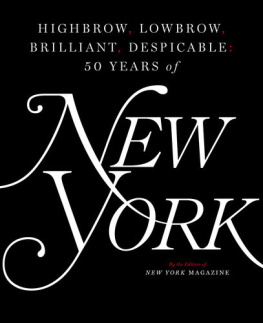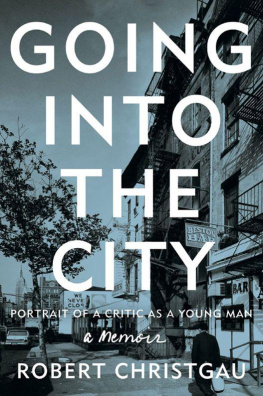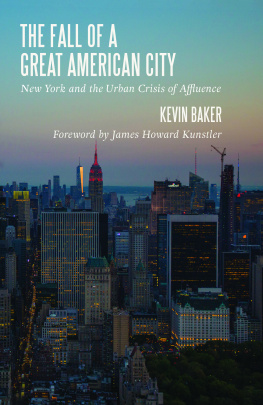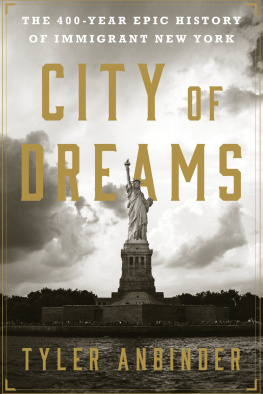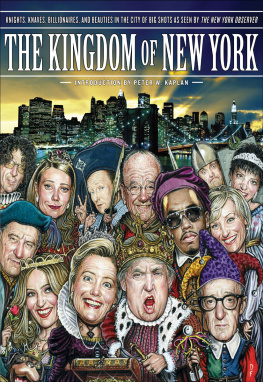Thank you for downloading this Simon & Schuster ebook.
Get a FREE ebook when you join our mailing list. Plus, get updates on new releases, deals, recommended reads, and more from Simon & Schuster. Click below to sign up and see terms and conditions.
CLICK HERE TO SIGN UP
Already a subscriber? Provide your email again so we can register this ebook and send you more of what you like to read. You will continue to receive exclusive offers in your inbox.
We hope you enjoyed reading this Simon & Schuster ebook.
Get a FREE ebook when you join our mailing list. Plus, get updates on new releases, deals, recommended reads, and more from Simon & Schuster. Click below to sign up and see terms and conditions.
CLICK HERE TO SIGN UP
Already a subscriber? Provide your email again so we can register this ebook and send you more of what you like to read. You will continue to receive exclusive offers in your inbox.
CONTENTS
FOREWORD
W HAT KIND OF A MAGAZINE takes New York as its name? An ambitious one, obviously. At its founding, New York saw as its rivals two established publications that already had New York in their titles the New York Times and The New Yorker but viewed both of them as stuffed shirts. New York would take them on by being the unpretentious New Yorkunapologetic, funny, brash, even a bit crude. It would sound like the city itself. And that made it, when it launched in 1968, an unusual specimen: One of its most radical principles was that it would approach New York not simply as a subject to cover but as a point of view. And because the point of view was that of the most worldly city in the world, its purview would be far-flung. The White House and the studio back lot would be as interesting to it as City Hall.
Even so, with the arrogance of a New Yorker, it believed that New York was the capital of the world, where everything began, and that meant New York was its first preoccupation. The city in 1968 was undergoing some monumentally interesting change. It was beset with blight, as people were leaving in droves. At the same time, it was serving as the cradle for great movementspolitical movements, social movements, consumer movementsthat would lift it out of its wreckage and ultimately invent a new kind of cosmopolitan creature that would reverberate throughout America and the world.
In a half century of episodic installments, New York told this dramatic story: the rebirth of a great city. This book is an attempt to put that story all in one place and to reconstruct how life in New York City changed, using the lens of New York s writers, editors, photographers, and designers who, week to week, chronicled that transformation.
It is not a book of greatest hits (although weve tried to include many) but one that uses the magazines material to trace the course of its namesake. The material did not always lend itself easily to that purpose. As we editors have made our way through five decades worth of back issues, we found that the story (the citys and the magazines) isnt exactly linear. Like all magazines, this one had its ups and downs. There have been times when the magazine caught the citys thrilling trajectory perfectly; there are also huge gaps in its coverage. New York was presciently early to many stories, right on time with others, embarrassingly late to some. And there are a few really strange turns: a 1970s obsession with houseplants, a cover story entirely devoted to Donald Trumps boat. A weekly magazine, putting out roughly 50 issues a year, made room for a substantial amount of variety, to say the least.
Because this book is coffee-table-size, with every page an overscale canvas, much of its narrative is visual, telling the story of the city through photographs and graphics and particularly magazine covers. (Also foldouts: Weve tried to veer off the grid from time to time, just as the citys streets do.) But we have also excerpted many pieces of landmark writing that, in our opinion, evoke an especially vivid memory of New York City at a particular moment. Rather than dividing up the story by decade, we decided to organize this book around eight themes of city life. They develop chronologically, except for times when we thought it was worth busting up the timeline. Wherever we could, we revisited the people who posed for our photographers or spoke to our reporters or wrote for our editors. There are behind-the-scenes moments about the ways in which these stories and images came to be and the lives they took on after we published them. As an introduction to the book, we have compiled an oral history of the magazine itself, as told by staff and executives, as well as (in a couple of cases) our journalistic subjects. There is, of course, one glaring absence from that group: Clay Felker, the co-creator of New York , who died in 2008. Felker was a hungry journalist from Missouri who had already established himself as a kind of magazine genius when he became editor of New York, which was first a supplement to the dying New York Herald Tribune. After the paper finally drew its last breath, he and his equally iconoclastic design partner, Milton Glaser, snatched the title and launched the magazine into the city and the world on its own.
PRETTY MUCH FROM ISSUE ONE, the magazine that Felker and his colleagues made was magnetic, and, as it turned out, they had called the future. New York exalted and lampooned the citys revolutions, and found tumult in places people hadnt looked before. It was obsessed with power and striving and movement. It was fearless, almost free-form, giddy with change, infatuated with the new. And the city gave it plenty of material. Starting in the late 1970s, after a near bankruptcy, New York Citys fortunes started to turn upward. Young people, despite the crime and the filth, began to move in again. Through the subsequent decades, those young professional peopleas a first approximation, they were what became yuppiesbecame emblematic of an urban revival. Movies and TV shows began to imagine New York not as a swamp of mayhem and corruption but as a fun, goofy place to live. Panic in Needle Park and Dog Day Afternoon gave way to Friends and Sex and the City and Girls . The half-imaginary city Felker sketched out in his magazine not only came to life but also became an actual place.
A city that at the magazines founding had been unable to balance its books was soon awash in moneyand, for a dozen years in the 21st century, was governed by its richest citizen. Wealth solved some problems and created others. What Does It Take to Get a Decent Apartment? the magazine asked in 1968, when the answer was $590 a month for a two-bedroom in the East 70s. Over the decades, as crime rates dropped and the cost of just about everything soared, the headaches of living in New York remained a preoccupation of the magazine. Neighborhoods were discovered, celebrated, overrun, declared over. Nightlife was perpetually on the brink of obliteration, thanks to one sanitization project or another (the Disneyfication of Times Square, the smoking ban), even as it was reinvented again and again by new generations of weirdos. Raising children in New York remained a high-wire act, the universal anxiety of parenting intensified by the echo chambers of the playground and the mommy blog. The city could be extraordinarily hostile to making artand yet, at the same time, devastatingly alluring. What Felker and his colleagues recognized in 1968 is that the difficulty of the city was also its charm. That is still true today.
So is New Yorks primacy as the place where things happen. Felker knew that a magazine grounded in the story of New York could also be a magazine about the whole world, and it is amazing how much history coursed through the citys streets. The 9/11 attacks, obviously. A few blocks west: the invention of collateralized mortgage obligations in 1983. A few blocks north: the Occupy Wall Street protests in 2012. Ms. magazine started in its pages in 1971. The city spurred multiple waves of feminism and celebrated the nomination of the first female major-party candidate for president. (It also saw its first Manhattan-developer president.) Soho artists invented a new way of living, something called the loft. Brooklyn became a lifestyle replicated the world over. The New York Police Department introduced two crime policiesbroken windows and stop and friskthat shaped the American justice system for better or worse. Saturday Night Live launched generations of comedians from 30 Rockefeller Plaza. One block away, Fox News revolutionized cable television and American politics. Martin Scorsese created a new language for movies. Dominique Ansel created the Cronut. And when New York did shift its focus elsewhere, it never had trouble writing about Washington or Hollywood or Silicon Valley because they traded in that common currency so central to the magazines ethos: ambition.
Next page


